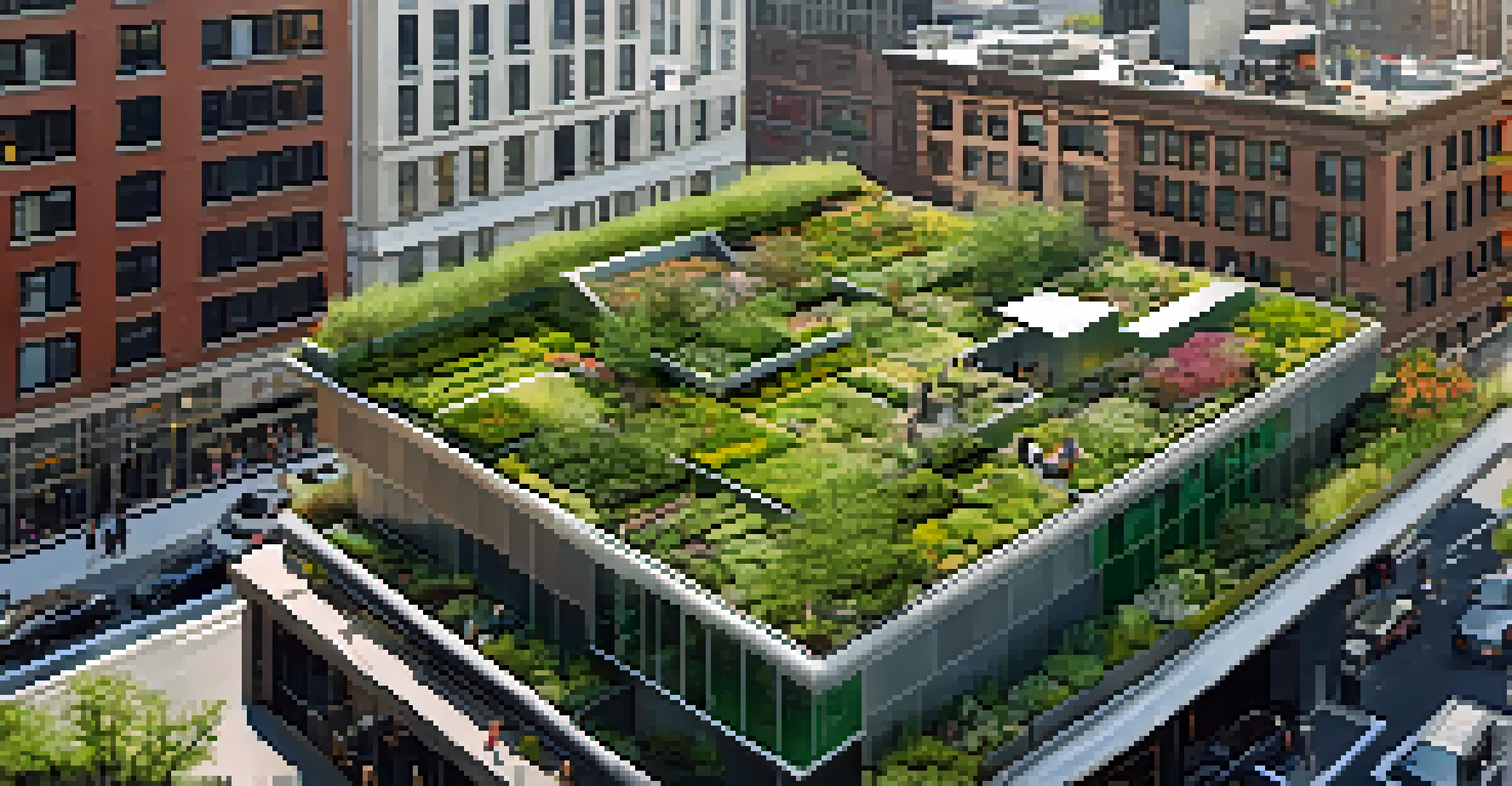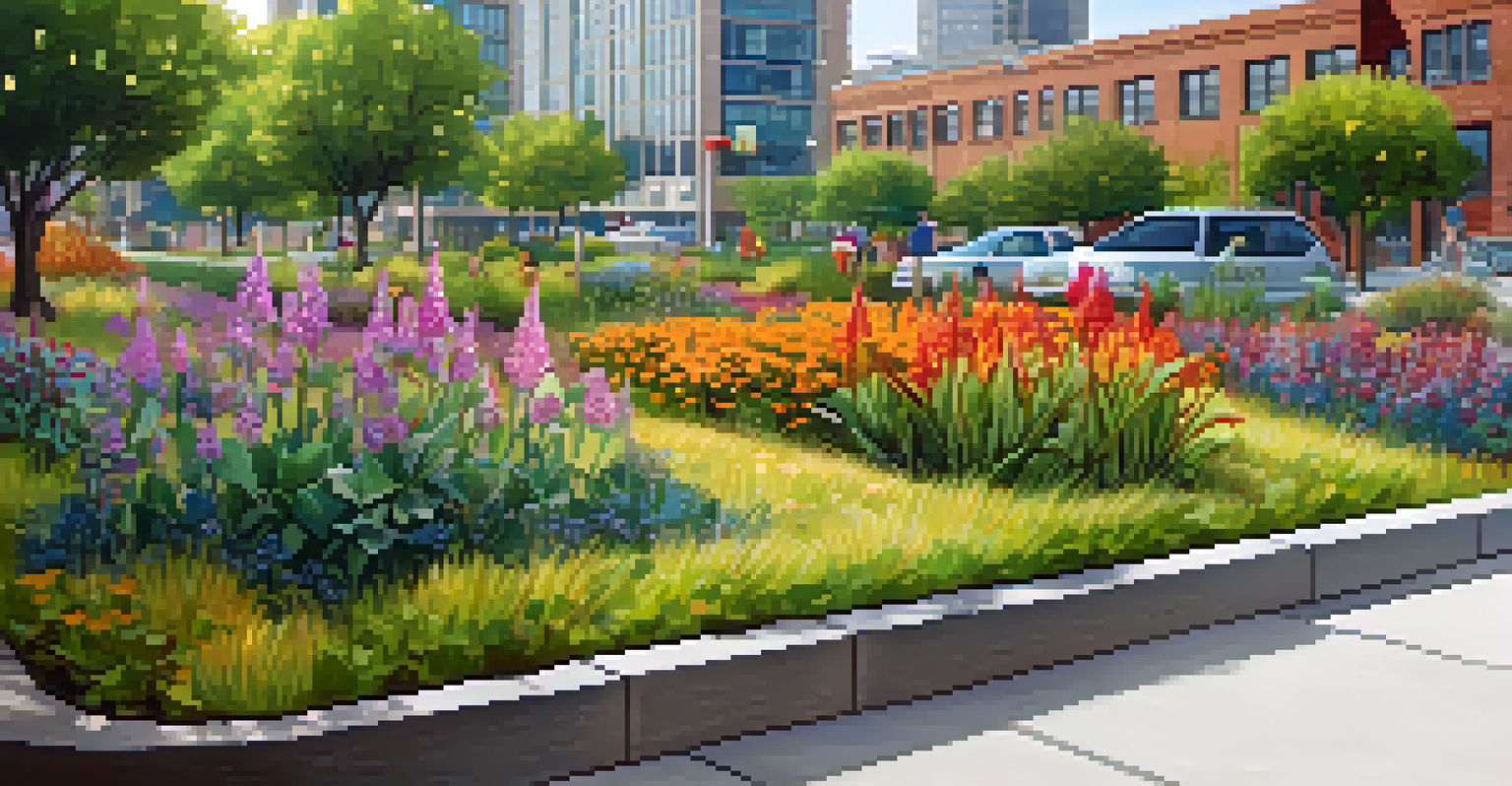New York City's Green Infrastructure Solutions for Climate Change

Understanding Green Infrastructure in NYC
Green infrastructure refers to natural systems and processes that improve urban environments. In New York City, this includes parks, green roofs, and rain gardens that help manage stormwater. These solutions not only mitigate flooding but also enhance the city's aesthetic and environmental quality.
We won't have a society if we destroy the environment.
By utilizing green infrastructure, NYC aims to create a more resilient city capable of withstanding climate change impacts. This approach contrasts with traditional grey infrastructure, which often leads to increased runoff and pollution. Green solutions work harmoniously with nature, providing multiple benefits beyond mere functionality.
One compelling example is the use of permeable pavements in various neighborhoods. These materials allow rainwater to seep through, reducing surface runoff and improving water quality. Such initiatives underscore the city's commitment to integrating nature into urban planning.
The Role of Parks in Climate Adaptation
Parks play a critical role in New York City's green infrastructure strategy. They serve as vital green spaces that absorb rainwater, reduce heat, and improve air quality. Central Park, for instance, is not just a recreational area; it acts as a crucial buffer against urban flooding.

Additionally, parks can help combat the urban heat island effect, where city temperatures are significantly higher than surrounding areas. By planting trees and expanding green spaces, NYC can lower temperatures, making neighborhoods more comfortable for residents. This is especially important during heatwaves, which are becoming more frequent.
Green Infrastructure Enhances Resilience
New York City's green infrastructure, including parks and green roofs, mitigates flooding and improves urban environments.
Community engagement in park maintenance and development fosters a sense of ownership and stewardship among residents. When locals participate in caring for their parks, they become more invested in their sustainability and overall health.
Green Roofs: A Layer of Protection
Green roofs are another innovative solution being implemented across NYC. These living roofs, covered with vegetation, provide numerous benefits, including stormwater management and insulation. They help absorb rainwater, reducing the burden on the city's sewer systems during heavy rainfall.
The environment is where we all meet; where we all have a mutual interest; it is the one thing all of us share.
In addition to environmental advantages, green roofs also contribute to energy efficiency in buildings. They help regulate indoor temperatures, potentially lowering heating and cooling costs. This dual benefit makes them an attractive option for building owners looking to enhance sustainability.
Moreover, green roofs can increase biodiversity in urban areas. By providing habitats for various species, they contribute to a healthier ecosystem within the city. This connection to nature can also improve the mental well-being of residents and workers alike.
Rain Gardens: Small Solutions with Big Impact
Rain gardens are specially designed landscapes that capture and filter stormwater runoff. These gardens use native plants that thrive in local conditions, making them a sustainable choice for urban areas. By absorbing excess rainwater, they help prevent flooding and reduce pollution in nearby waterways.
New York City has been integrating rain gardens into its streetscapes and public spaces. These installations not only address stormwater management but also beautify neighborhoods, making them more inviting. Residents benefit from enhanced green spaces while contributing to climate resilience.
Community Engagement is Essential
Involving residents in the planning and maintenance of green projects fosters a sense of ownership and strengthens community ties.
Creating awareness about the importance of rain gardens is essential. Educational programs can empower communities to participate in their development and maintenance, fostering a culture of environmental stewardship. This collective effort can lead to significant improvements in urban resilience.
Urban Forestry: Trees as Climate Allies
Urban forestry is a cornerstone of NYC's green infrastructure efforts. Trees absorb carbon dioxide, provide shade, and improve air quality, making them vital allies in the fight against climate change. The city's commitment to increasing tree canopy coverage reflects a long-term vision for a healthier urban environment.
Planting trees in strategic locations helps mitigate the urban heat island effect, thus reducing energy consumption during hot months. Neighborhoods with ample greenery often report lower temperatures, leading to more comfortable living conditions. These benefits extend beyond environmental impact, enhancing the quality of life for residents.
Moreover, engaging communities in tree planting initiatives fosters a connection to nature. Educational programs can teach residents about the importance of urban trees, encouraging them to care for their local environment. This community involvement is crucial for the long-term success of urban forestry projects.
Innovative Stormwater Management Techniques
Innovative stormwater management techniques are essential for adapting to climate change in NYC. These methods often incorporate green infrastructure elements like bioswales, which are designed to capture and filter runoff. Through these systems, the city can better manage heavy rainfall events and reduce the risk of flooding.
Bioswales not only improve water quality but also enhance the aesthetics of urban spaces. They transform what would be mere drainage ditches into lush, green areas that benefit both the environment and the community. This dual purpose makes them appealing for urban planners and residents alike.
Innovative Solutions for Stormwater
Techniques like bioswales and rain gardens are vital for managing stormwater and adapting to climate change in NYC.
As NYC continues to face increasing rainfall and severe weather, adopting these innovative solutions is imperative. By investing in sustainable stormwater management, the city can protect its infrastructure and residents while paving the way for a greener future.
Community Involvement in Green Solutions
Community involvement is crucial for the success of NYC's green infrastructure initiatives. Engaging residents in the planning and maintenance of green projects fosters a sense of ownership and responsibility. This collective effort can lead to more sustainable and resilient urban environments.
Local organizations and volunteer groups often play a key role in implementing green solutions. From tree planting events to rain garden installations, community members contribute their time and skills to enhance their neighborhoods. This hands-on approach not only beautifies the city but also strengthens community ties.

Educational programs that raise awareness about the benefits of green infrastructure can inspire more people to get involved. By understanding how these solutions impact their lives, residents are more likely to advocate for and participate in sustainable initiatives. This grassroots movement is essential for creating a lasting impact on NYC's climate resilience.
The Future of Green Infrastructure in NYC
The future of green infrastructure in New York City looks promising as climate change challenges continue to grow. Ongoing investments in sustainable solutions highlight the city's commitment to resilience and sustainability. By prioritizing green infrastructure, NYC can adapt to changing weather patterns while enhancing urban living.
As technology advances, innovative solutions will likely emerge, paving the way for even more effective green infrastructure. Collaborations between government agencies, nonprofit organizations, and local communities will be instrumental in driving these initiatives forward. This united approach will ensure that green solutions are both practical and impactful.
Looking ahead, the integration of green infrastructure into urban planning will become increasingly vital. As more cities worldwide adopt similar strategies, NYC can serve as a model for others aiming to combat climate change. The journey towards a greener, more sustainable city is ongoing, and every step counts.